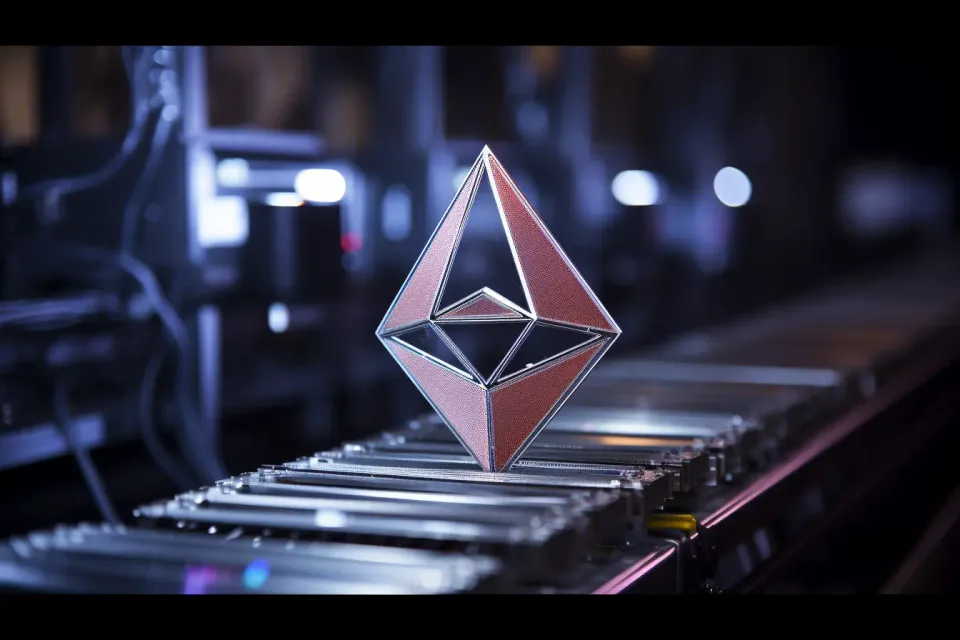What is Ethereum Virtual Machine and How Does it Work?
A revolutionary concept of the Ethereum Virtual Machine (EVM) exists since the establishment of the Ethereum blockchain. The EVM is a decentralized computational engine that allows for the execution of smart (autonomous) contracts on the Ethereum blockchain. These contracts, written in a programming language called Solidity, can automate complex business processes, making transactions transparent and tamper-proof.
The EVM's significance in the crypto industry cannot be understated. Over the years, it has become the de facto standard for executing decentralized applications (dApps) and smart contracts. Its robustness, flexibility, and widespread adoption have made it a benchmark for other blockchains aiming to offer similar capabilities.
Today, there are hundreds of new EVM-compatible blockchains that aim to achieve EVM compatibility to take advantage of its vast developer community and rich ecosystem of decentralized apps. But what is an EVM exactly is, and what made it so popular?
Understanding Ethereum Virtual Machine
The Ethereum Virtual Machine (EVM) serves as the computational core of the Ethereum network, responsible for interpreting and executing smart contracts.
Before delving deeper into the EVM, it's essential to understand what a “virtual machine” is. In computing, a virtual machine (VM) is a software-based emulation of a physical computer. Just as a physical computer has a processor, memory, and storage, a VM replicates these components in software, allowing it to run applications and perform tasks as if it were a real computer. Think of it as a computer within a computer, where the inner computer is virtual and runs in an isolated environment.
Back to the EVM: smart contracts, typically written in languages such as Solidity, are compiled into bytecode, a low-level, machine-readable format that the EVM processes.
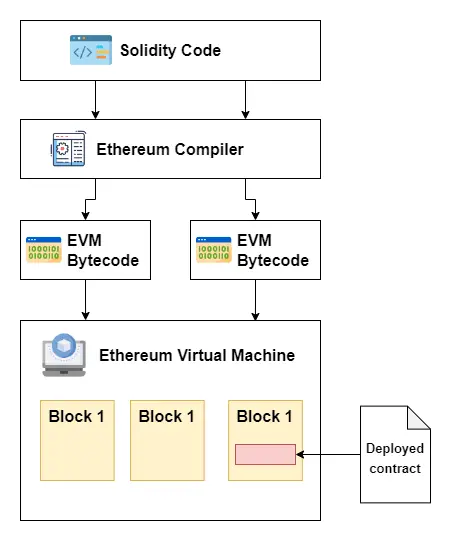
Each node in the Ethereum network houses a replica of the EVM. This ensures that autonomous contracts are executed uniformly across the entire network. In the context of decentralized systems, this uniformity is crucial. Unlike centralized systems where a single entity or server might dictate outcomes, in decentralized systems, trust is derived from consensus among multiple participants and the transparency of code execution.
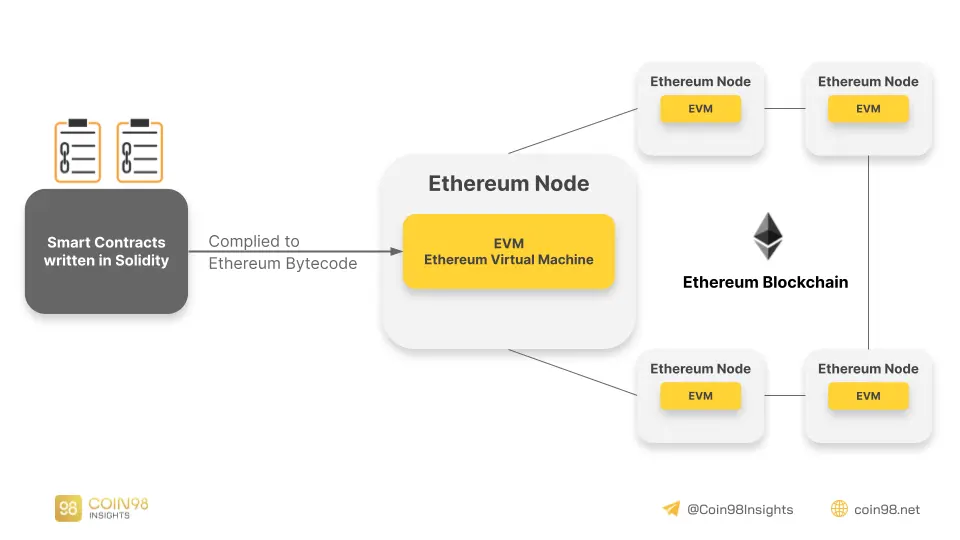
A distinguishing feature of the EVM is its capacity to function in a trustless environment. Traditional computer systems often rely on intermediaries or trusted third parties. For instance, when you make an online purchase, payment gateways or banks act as intermediaries to process the transaction. In contrast, with the EVM, code execution is transparent, deterministic, and can be verified by all parties, ensuring outcomes that are consistent and resistant to tampering.
Moreover, the EVM operates within a sandboxed environment. This means that each smart contract's execution is isolated, similar to how individual applications on a computer are contained to prevent system-wide crashes or vulnerabilities. This design choice is intended to safeguard the broader Ethereum network's security and integrity, even if a specific contract behaves unpredictably.
Designed with a vision for adaptability, the EVM can adjust to the ever-changing digital landscape. Its open-source foundation encourages contributions from a global community of developers. While the EVM has made significant strides, it, like all technologies, continues to evolve and face new challenges.
What Does “Turing-Complete” Mean?
The term “Turing-complete” signifies that a system has the computational prowess to simulate any other system, given enough time and resources. In the context of the EVM, this means unparalleled versatility. Ethereum isn't restricted to simple token transactions; its Turing-complete nature allows it to host a myriad of applications, from decentralized finance platforms to digital art marketplaces. The EVM's Turing-completeness, combined with its decentralized architecture, offers a promise of a future where applications are limited only by the imagination of their creators.
History of Ethereum Virtual Machine
Throughout its history, the EVM has navigated numerous adversities, assimilated emerging technological shifts, and consistently fortified its capabilities with each successive version:
Inception:
- 2013: Vitalik Buterin proposed Ethereum, highlighting the EVM's potential as a Turing-complete machine, setting it apart from Bitcoin's limited scripting.
- 2015: Ethereum's “Frontier” marked the EVM's debut, enabling developers to deploy smart contracts.
Evolution through Upgrades:
- Homestead (2016): The first major upgrade post-Frontier.
- Metropolis-Byzantium (2017): Introduced enhancements to the EVM's efficiency and capabilities.
- Metropolis-Constantinople (2019): Further refined the EVM's operations.
- Istanbul (2020): This upgrade brought about significant changes to the EVM, including gas cost recalibrations.
- Muir Glacier (2020): A focused upgrade to delay the Ethereum “difficulty bomb”.
- Berlin (2021): Fine-tuned the EVM's gas dynamics and transaction formats.
- London (2021): A landmark upgrade, introducing EIP-1559, which revolutionized how the EVM processes gas fees.
Innovations and Future Directions:
- eWASM: Emerged as a potential successor or complement to the EVM, aiming for swifter smart contract execution and enhanced interoperability.
- Layer 2 Solutions (2020-2023): To address scalability challenges, solutions like Optimism and zk-Rollups have been developed, optimizing the EVM's performance.
What are Opcodes?
Opcodes, short for operation codes, are the fundamental instructions that the EVM interprets and executes. These are the atomic elements that make up the bytecode of Ethereum smart contracts. Each opcode corresponds to a specific operation, ranging from arithmetic calculations to more complex data manipulations. Below, you can see a few examples of EVM opcodes and corresponding operations:

The full list of opcodes can be found here.
In EVM, opcodes act as the signposts, guiding the execution of autonomous contracts. Their deterministic nature ensures that every node in the Ethereum network interprets them identically, a crucial feature for maintaining network consensus.
As developers craft smart contracts, high-level programming languages like Solidity are used, which are then compiled down to these opcodes, ensuring efficient and consistent execution on the EVM. The meticulous design of these opcodes and their careful implementation ensures that smart contracts run seamlessly, making Ethereum a robust platform for decentralized applications.
What Is the Purpose of the EVM?
The EVM serves multiple pivotal roles within the Ethereum ecosystem:
- At its core, it provides a standardized environment for the execution of smart contracts. This standardization ensures that regardless of where a contract is executed within the network, the outcome remains consistent.
- Beyond this, the EVM acts as a protective barrier, isolating smart contracts from the broader Ethereum network. This isolation is crucial for security, ensuring that faulty or malicious contracts cannot harm the network at large.
- Additionally, the EVM promotes innovation by providing developers with a flexible platform to build upon. Its Turing-completeness means that the possibilities are virtually endless, allowing for the creation of diverse applications, from simple token exchanges to intricate decentralized platforms.
In essence, the EVM is the engine that powers the vast world of Ethereum, driving its vision of a decentralized, transparent, and inclusive digital future.
How Does the EVM Work?
The EVM operates in a systematic and methodical manner. When a smart contract is called upon, its corresponding bytecode is fed into the EVM for execution. The EVM then processes this bytecode, opcode by opcode, utilizing its stack-based architecture. Each opcode might alter the state of the EVM, consume a certain amount of gas, or even call upon other contracts.
The deterministic nature of the EVM ensures that every node in the Ethereum network processes these opcodes identically, leading to a consistent state across the entire network. This consistency is paramount for maintaining trust in a decentralized system.
Furthermore, the EVM's design ensures that while it can interact with the broader Ethereum network, it remains isolated, ensuring that any issues or bugs within a contract don't compromise the network's integrity.
EVM Using Opcodes
Delving deeper into the EVM's operation, opcodes play an instrumental role here. These are the granular instructions that the EVM deciphers and acts upon. When a smart contract is deployed or invoked, its associated bytecode, a series of opcodes, is executed by the EVM.
This process is akin to how traditional computers interpret machine code. However, in the EVM's decentralized context, the emphasis is on deterministic execution to ensure network-wide consistency.
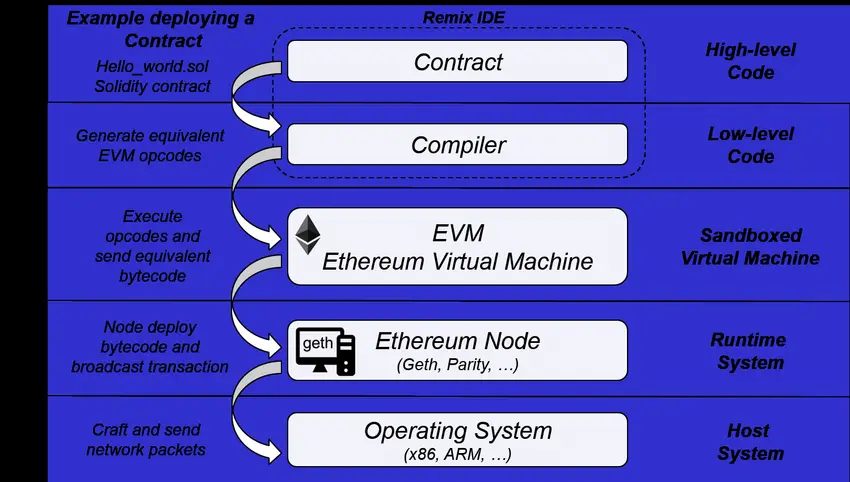
Each opcode has an associated gas cost, reflecting the computational effort required for its execution. By processing these opcodes in a sequential and systematic manner, the EVM ensures that autonomous contracts run as intended, providing a reliable foundation for decentralized apps on the Ethereum platform.
Gas Fee Calculation
Gas acts as the fuel that powers smart contract execution in EVM. Every operation, from simple arithmetic to data storage, has an associated gas cost. When a user initiates a transaction or invokes a smart contract, they specify a gas limit and a gas price.
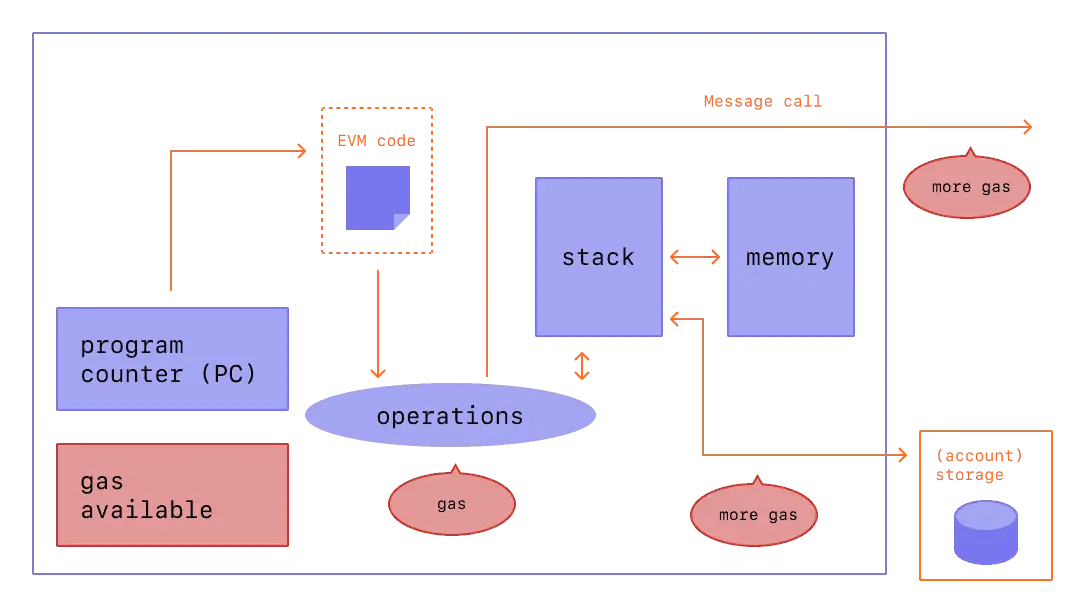
Think of “gas” in Ethereum like fuel for a car. Just as different car activities (like driving uphill or using air conditioning) consume different amounts of fuel, different activities on Ethereum (like sending Ether or using a smart contract) use different amounts of gas.
Now, when you want to do something on Ethereum, you decide two things:
- Gas Limit: It is like deciding the maximum amount of fuel you're willing to use. For instance, you might say, “I'm willing to use up to 21,000 GAS”.
- Gas Price: It is a.k.a. deciding the price you're willing to pay for each liter/gallon of fuel. Let's say you're okay with paying “100 Gwei” for each unit of gas.
To find out the total cost, you'd multiply the two:
21,000 GAS × 100 Gwei = 2,100,000 Gwei (which is a fraction of an Ether).
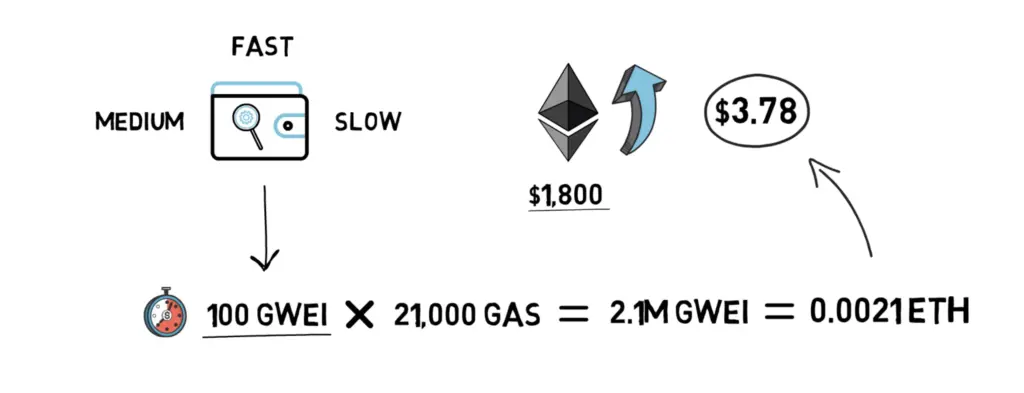
The EVM then looks at what you want to do and calculates how much gas it will need. If your activity ends up needing more gas than your limit (like if your car runs out of fuel), the action stops (or “reverts”). However, you still pay for the gas used up to that point. This system prevents people from accidentally clogging up the network or running faulty code endlessly. It also encourages developers to make their code as gas-efficient as possible, so it costs less to run.
Functions of an EVM
The EVM serves several key functions:
- Smart Contract Execution: When a smart contract is called, the EVM securely executes its code with the terms of agreement.
- Isolation: The EVM operates in a sandboxed environment, meaning it's isolated from the main Ethereum network. This ensures that any issues or bugs in a smart contract don't affect the broader network.
- Consensus Mechanism: When nodes on the Ethereum network validate transactions, they use the EVM to execute smart contract code and come to a consensus about the outcome.
- Gas Calculation: The EVM calculates the total gas used for each transaction, ensuring that users pay for the computational work required for their transactions.
Why Use the EVM for Building Web3 Apps?
Web3 represents the next evolution of the internet, emphasizing decentralization, trustless transactions, and user empowerment. The EVM, with its robust architecture and developer-friendly environment, is perfectly poised to drive this revolution. Building Web3 apps on the EVM offers several advantages.
Enhanced Interoperability
The EVM's standardized environment ensures that Web3 apps can seamlessly interact with each other and with other blockchains. This interoperability fosters a rich ecosystem where apps can leverage each other's capabilities, creating synergistic experiences for users.
Security and Reliability
The EVM's decentralized and deterministic nature ensures that Web3 apps are resistant to censorship, tampering, and single points of failure. This robustness is crucial for apps that handle sensitive data or financial transactions.
Easy Migration to Other Blockchains
The EVM's modular design allows for easy migration of Web3 apps to other EVM-compatible blockchains. This flexibility ensures that apps are not locked into a single blockchain and can leverage the strengths of various platforms.
Supports a Range of Scripting Languages
Developers are not restricted to a single language when building on the EVM. It supports a variety of scripting languages, allowing developers to choose the one that best suits their project's needs.
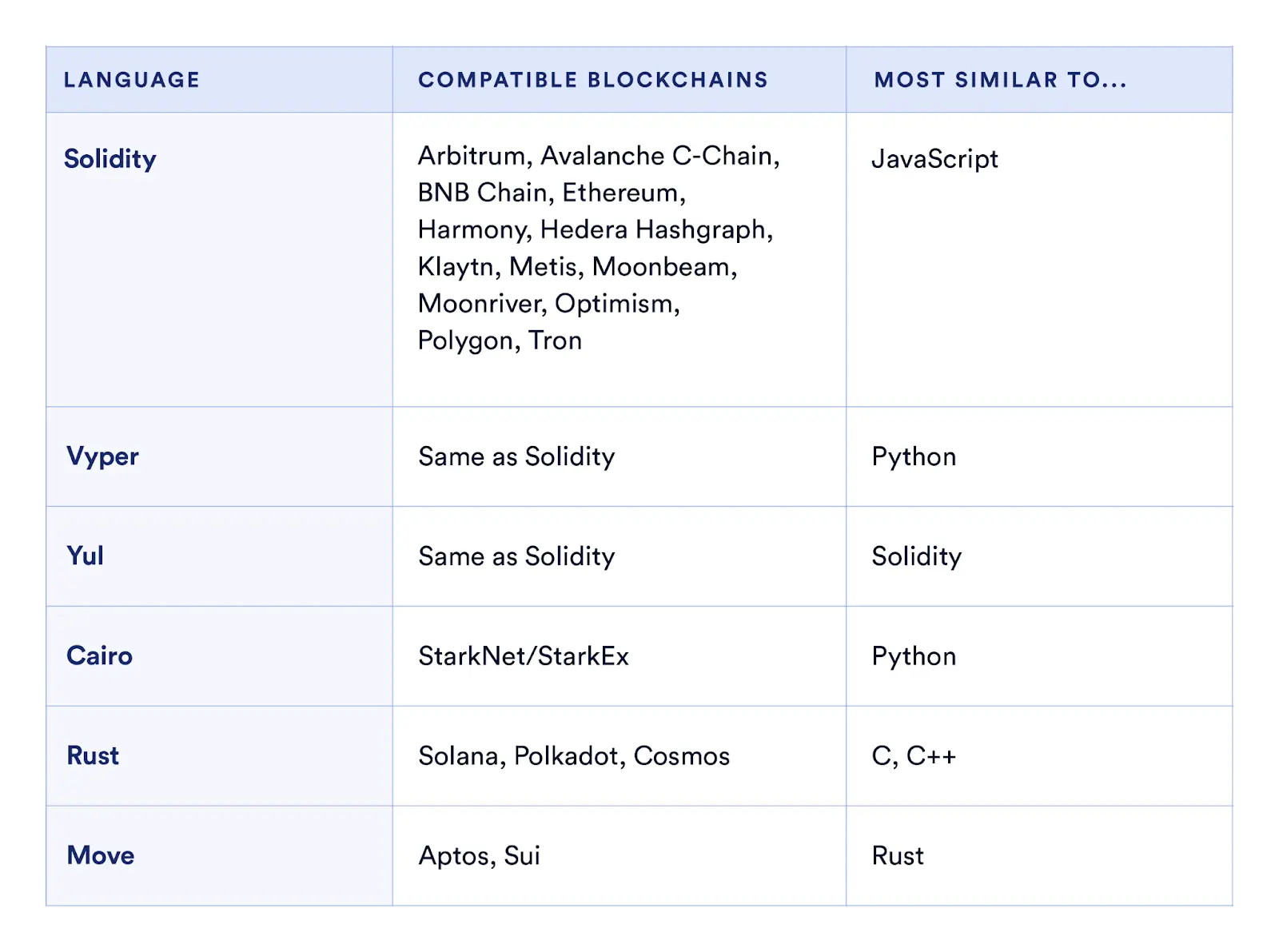
Distributed Consensus
The EVM operates on a distributed consensus mechanism, ensuring that all nodes agree on the state of the blockchain. This consensus ensures the integrity and trustworthiness of Web3 apps built on the platform.
EVM-compatible Blockchains
The success and robustness of the EVM have inspired several other blockchains to adopt its architecture, leading to the emergence of EVM-compatible chains. These chains offer the same functionalities as Ethereum, but often come with their own unique features or optimizations.
Ethereum Classic
Ethereum Classic (ETC) is the original version of the Ethereum blockchain, preserved after the DAO hack and the subsequent hard fork that led to the creation of Ethereum (ETH). While it shares many similarities with Ethereum, Ethereum Classic emphasizes immutability and the principle that “code is law”. It retains compatibility with the EVM, allowing developers to deploy autonomous contracts just as they would on Ethereum.
Binance Smart Chain
Binance Smart Chain (BSC) is an EVM-compatible blockchain platform developed by the crypto exchange Binance. The compatibility with EVM enables BSC to run Ethereum-based applications. It offers faster transaction times and lower fees compared to Ethereum, making it a popular choice for many decentralized applications and DeFi projects.
Polygon (previously Matic Network)
Polygon aims to transform Ethereum into a multichain system. While it started as the Matic Network, it has since evolved to support various scaling solutions for Ethereum. Being EVM-compatible, it offers a seamless environment for deploying and running Ethereum applications, with the added benefits of faster and cheaper transactions.
Gnosis Chain (previously xDai)
Gnosis Chain, rebranded from xDai, is a unique EVM-compatible chain that uses the stablecoin DAI as its native cryptocurrency. This ensures stable transaction fees, making it an attractive platform for many developers. xDai prioritizes user experience and boasts fast transaction times, making it suitable for everyday transactions and microtransactions.
TomoChain
TomoChain is a scalable blockchain platform that offers near-zero fees and fast transaction times. While it introduces its consensus mechanism and innovations, it remains EVM-compatible, allowing for easy migration of Ethereum applications. TomoChain focuses on providing a seamless experience for both developers and users, emphasizing user-friendly tools and integrations.
Benefits of Ethereum Virtual Machine
The Ethereum Virtual Machine offers a plethora of advantages. Its decentralized nature ensures that applications are censorship-resistant and free from central points of control. The EVM's Turing-completeness allows for the creation of complex and versatile smart contracts, catering to a wide range of applications from simple token transfers to intricate decentralized platforms.
EVM’s compatibility with various programming languages ensures that developers have the flexibility to choose the best tools for their projects. Moreover, the EVM's emphasis on security, combined with Ethereum's vibrant community, ensures that it remains at the forefront of blockchain technology, continually evolving to meet the challenges of the ever-changing digital landscape.
Downsides of Ethereum Virtual Machine
While the EVM boasts numerous advantages, it's not without its challenges. The gas fee mechanism, although designed to prevent spam and incentivize efficient coding, can lead to high transaction costs during network congestion. The EVM's emphasis on decentralization and security sometimes comes at the expense of scalability, leading to bottlenecks during high demand periods.
Additionally, the EVM's deterministic nature, while essential for network consensus, can make it challenging to introduce randomness or external data without relying on oracles or other third-party solutions.
The Future of EVM
The EVM has been a cornerstone of the Ethereum platform since its inception. However, as the blockchain ecosystem evolves, so does the technology that underpins it. With the advent of Ethereum 2.0, there are plans to potentially replace the EVM with eWASM (Ethereum-flavored WebAssembly). eWASM promises faster smart contract execution and enhanced interoperability, addressing some limitations of the current EVM.
Despite these changes, the legacy of the EVM remains influential. The emergence of EVM-compatible chains underscores its foundational role in the blockchain world. These chains adopt the EVM's architecture while introducing their unique features, attesting to the EVM's adaptability and robustness.
In the broader context, Ethereum 2.0 aims to bring about significant improvements in scalability and energy efficiency. As the transition unfolds, the principles and functionalities pioneered by the EVM will continue to inspire and shape the future of decentralized apps and platforms.
FAQ
Does Ethereum Use Virtual Machines?
Yes, Ethereum utilizes the EVM to process and execute autonomous contracts. The EVM is an integral part of the Ethereum ecosystem, ensuring that smart contracts run consistently across all nodes in the network. It acts as a decentralized computational engine, interpreting and executing the bytecode of smart contracts.
What Are the Benefits of an Ethereum Virtual Machine?
Firstly, it provides a standardized environment for smart contract execution, ensuring that every transaction is processed uniformly, maintaining the trust and integrity of the decentralized system. Additionally, the EVM's compatibility with various programming languages offers flexibility, and its decentralized nature ensures applications are resistant to censorship and external manipulation.
How Big Is the Ethereum Virtual Machine?
The EVM isn't “big” in the traditional sense of storage or physical size. Instead, it's a conceptual machine that exists in the Ethereum protocol, ensuring that all nodes in the Ethereum network process transactions in the same way. Every Ethereum node runs its instance of the EVM to validate and execute transactions. The “size” of the EVM would refer to its computational capacity, determined by the collective computational power of all nodes in the Ethereum network.
What Is EVM?
The Ethereum Virtual Machine (EVM) is the runtime environment for contracts execution on Ethereum. It enables the decentralized execution of code. In essence, the EVM ensures that smart contracts, once deployed, run exactly as programmed without any possibility of downtime, censorship, fraud, or third-party interference. It achieves this by ensuring that every node in the Ethereum network arrives at the same result for each transaction, thereby maintaining network-wide consensus.
*This communication is intended as strictly informational, and nothing herein constitutes an offer or a recommendation to buy, sell, or retain any specific product, security or investment, or to utilise or refrain from utilising any particular service. The use of the products and services referred to herein may be subject to certain limitations in specific jurisdictions. This communication does not constitute and shall under no circumstances be deemed to constitute investment advice. This communication is not intended to constitute a public offering of securities within the meaning of any applicable legislation.

